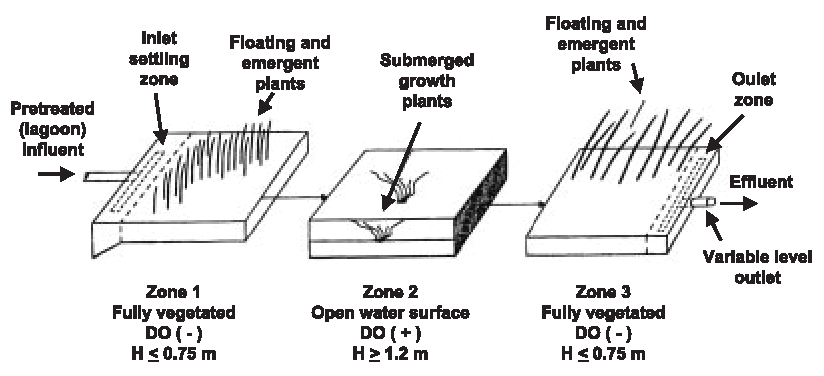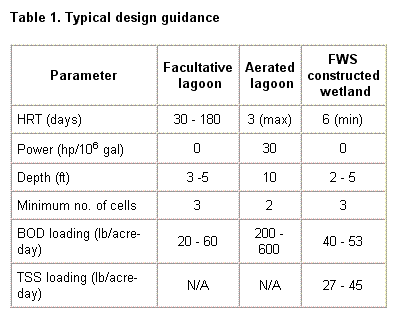

Stabilization Ponds, FWS Constructed Wetlands, and Other Aquatic Systems...
Description...
Aquatic systems are large basins filled with wastewater undergoing some combination of physical, chemical, and/or
biological treatment processes that render the wastewater more acceptable for discharge to the environment (Figure 1).
They are not widely used because they tend to be large in area, require some form of fencing to minimize human health
risk, often require supplemental treatment before discharge or reuse, and are approved in only a few states.

Figure 1. Generic aquatic lagoon system.
Stabilization ponds (lagoons) have many forms, but the facultative lagoon is the most widely used. Aerated lagoons are
often preferred because of their smaller size requirements. Anaerobic lagoons and maturation ponds are not used in the
United States for onsite application by design. In some areas, lagoons must be lined according to codes, which further
limits their application. Facultative lagoons are large in size, perform best when segmented into at least three cells, obtain necessary oxygen for treatment by surface reaeration from the atmosphere, combine sedimentation of particulates
with biological degradation, and produce large quantities of algae, which limits the utility of their effluent without further treatment. A typical facultative lagoon is shown in Figure 2.

Figure 2. Generic facultative lagoon.
Aerated lagoons use mechanical equipment to enhance and intensify the biodegradation rate. They do not produce the intense algal load on downstream processes and have smaller areal requirements than facultative systems. Free water surface (FWS) constructed wetlands have also been used, though rarely, for similar reasons. These systems perform best when divided into
a minimum of three zones, the first and last being fully vegetated with macrophytes (cattails or bulrushes) and the middle having an open water surface, which performs like a facultative lagoon. In the first zone, the influent is suspended and colloidal solids are flocculated and settled under anaerobic or anoxic conditions. The second zone reaerates the anaerobic wastewater to provide oxygen for aerobic biodegradation and possible nitrification before the final-zone flocculation and sedimentation (and denitrification) steps. An FWS constructed wetland is shown in Figure 3.

Figure 3. Elements of a free water surface (FWS) constructed wetland.
Typical Applications...
Facultative lagoon systems, like evaporative (ET) systems, are not widely used for onsite wastewater treatment. They are large in size, are expensive to build, perform only a portion of the treatment necessary to permit surface discharge or
reuse (Table 1), and produce large concentrations of algae, which negates their use as direct pretreatment before soil infiltration. They have been used in a few states as an alternative system when a subsurface wastewater infiltration system (SWIS) is not feasible, usually to discharge without further treatment to surface waters, which is generally unacceptable under normal circumstances. In some states intermittent discharge lagoons are required. Storage volume is for all cold weather months (4 to 6 months), making the size of these systems too large for most applications.
Aerated lagoons require far less land and could theoretically be used in place of aerobic biological treatment, but they cannot be buried and insulated in northern climates like those units. They could be used in southern climates as
pretreatment for SWISs and would otherwise have similar features to the fact sheets that describe those systems.
FWS constructed wetlands reliably produce an advanced secondary effluent and can be employed for significant nitrogen removal. They require large land areas, similar to facultative lagoons. Their effluent quality is excellent for SWIS application, but they require disinfection for surface discharge and many reuse options. They have a highly desirable appearance, which often makes them the preferred alternative for owners with sufficient land areas.
All of these aquatic systems should be placed after the septic tank and before the disinfection or SWIS steps in the treatment train.

Performance...
Facultative lagoons are capable of 75 to 95 percent BOD removal, but TSS removal varies widely because of algal growth. During nonalgal periods, up to 90 percent TSS removal is possible, but during warm seasons TSS removal can be negligible.
In summer months 80 percent of the ammonia-nitrogen is nitrified, total nitrogen removal can reach 60 percent, and total phosphorus removal can approach 50 percent. Very long detention times in hot climates can reduce fecal coliforms to levels that can often meet surface water discharge standards, but typical U.S. retention times reduce fecal coliforms by 2 to 3 logs/100 mL.
Aerated ponds have removal capabilities similar to facultative lagoons, except that TSS removal is more consistent with aerobic biological systems (20 to 60 mg/L). Nitrification of ammonia-nitrogen can be nearly complete in warm seasons, while cold weather will halt that process. Some minimal phosphorus and nitrogen removal (10 to 20 percent) can be anticipated. Fecal coliform removal of 1 to 2 logs/100 mL is likely.
FWS systems can produce effluent BOD and TSS of 20 to 30 mg/L and can reduce nitrogen significantly. TP reduction is generally minor and similar to that of lagoons. Fecal coliform removals of about 2 to 3 logs (99 to 99.9 percent) can be expected.
Management Needs...
Aquatic systems are normally excavated in natural soil and constructed with earthen dikes. They may or may not be lined, depending on soil type. Sufficient freeboard (up to 2 feet) must be provided to prevent topping during high winds. In some cases the lagoon may act as a percolation pond, allowing effluent to infiltrate into the underlying soil. When used, mechanical aeration devices must be installed and fixed in place. Aerators may be mounted on piers or floats. Appropriate controls and electrical connections must be provided. Inlets should be located as far away from outlets as possible, and
both should be accessible for normal maintenance. Piping and pumps, as required, should be of corrosion-resistant materials, and pumps should be readily accessible. Fencing will normally be required to restrict access by the public.
The operation and maintenance of aquatic systems is typically minimal. Some attention must be paid to flow monitoring and adjustments, as required. Inlet and outlet structures, berms, and surface blockages should be inspected and maintained.
The use of mechanical aeration will require operation and maintenance tasks but less than those for extended aeration systems. Sludge management is relatively simple, since sludge builds up very slowly over a period of 10 to 15 years. Pretreatment of lagoon influent by septic tanks will greatly reduce sludge accumulations in the lagoon. Requiring septic tanks for individual homes or facilities served by lagoon cluster systems is recommended. Monitoring of effluent quality
for parameters of interest should be provided.
Only aerobic ponds require energy and semiskilled operators. Energy costs are in the range of $150 to $250 per year, and labor costs would be $200 to $250 per year. Sludge production would be similar to aerobic units. Facultative lagoons and
FWS systems require nonskilled O/M personnel to visit the facility two to three times per year. Sludge removal will be required every 10 to 15 years at most. A fence around the facility usually satisfies safety needs.
Risk Management Issues...
Aquatic systems, particularly facultative lagoons and FWS constructed wetlands, are large, passive systems that are
minimally affected by flow variations, extreme cold, and power outages. The risk of drowning can be mitigated only with restricted access, such as that provided by fencing and signage. Aerated lagoons are negatively affected by toxic loads, extreme cold, and power outages. Both lagoon types can be overloaded, resulting in odors, and the aerated type may become odorous during power outages. Poorly maintained facultative lagoons and FWS systems can become sources of vector problems such as mosquito infestations. FWS systems can be negatively affected by extended toxic discharges, but their aesthetic
image is extremely positive.
Costs...
Capital costs for a facultative lagoon for an individual home would be in the range of $2,500 to $7,500, whereas an aerated lagoon should cost somewhat more. An FWS system would cost $2,000 to $4,000. Operation and maintenance costs for the facultative lagoon and FWS systems should be less than $100 per year, whereas O/M costs for the aerated lagoon (including power) would be $350 to $500 per year.






